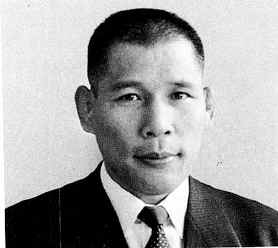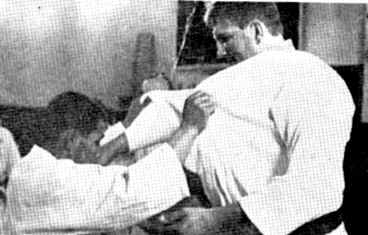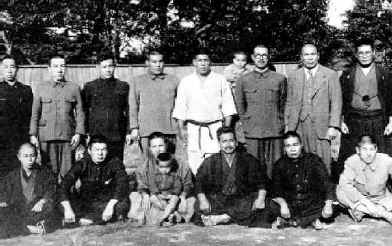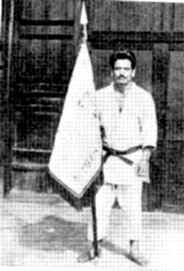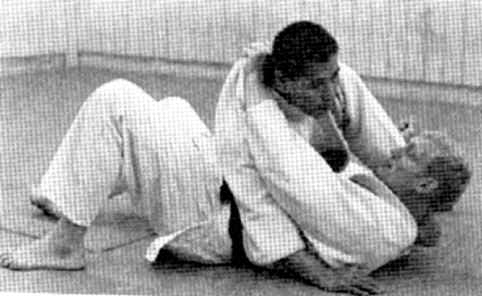The Man Who Revolutionized JudoBy Jim Chen, M.D., and Theodore Chen
Tokio Hirano (5’5”, 75 kg), obtained Godan (5th dan) at age 19, is perhaps the greatest Judo technician of all time. He is probably the best known Japanese Judoka in Europe. In 1952, Hirano went to teach Judo in Europe. Within six years, he had accumulated over 4,300 wins. In order to promote Judo, Hirano would fight all black belts in the city where he taught Judo. In November 1954, in Mannheim, Germany, Hirano scored all ippons in 34 minutes against 54 black belt opponents (1-3 dan). Traditional nage-waza (throwing techniques) were taught in the following sequence: kumu (gripping), tsukuru (the entry and proper fitting of your body into position taken just before the movement required for completion of your throwing technique), kakeru (completing), and nageru (throwing). Hirano revolutionized the order to tsukuru, kumu, kakeru and nageru. This is the current European style Judo. This is a proven method to defeat bigger opponents, as demonstrated by Hirano's stunning success. Wilhelm Ruska (Holland) 192 cm, 115 kg, was his most accomplished student. Ruska was the world heavyweight champion in 1967 and 1971 and runner up in 1969 (open weight). Wilhelm was the dual gold medallist in heavy and open weight class at the 1972 Munich Olympics. Win Against European Wrestling Champion
In the spring of 1955, Hirano went to teach in Amsterdam, Holland. He was challenged by Peter Artz (four time European free style wrestling heavy weight champion). Hirano agreed to both a Judo and wrestling fight. Each match was for ten minutes. The wrestling match would be decided by pinning the back for ten seconds. The Judo match would decided by a clean throw. At the start of the wrestling match, Hirano was able to throw Artz several times, but was unable to pin him due to perspiration (they fought without a Judo gi). About six minutes into the fight, Hirano made a Kiai. He jumped and grabbed Artz’s head and threw him with a koshi-guruma, pinned him with kesa-gatame for ten seconds,winning the wrestling match. In the Judo match, there was no contest. Within 30 seconds Hirano threw Artz cleanly with ippon seoinage. Fourteen Wins At Kodokan – 1941
During Judo's one hundred year history, the easiest way to get a rank promotion from Kodokan was to take part in the Kohaku Shiai (red-white team competition) which was held twice a year (Spring and Fall). By winning with 5 ippons one could receive a one dan promotion the same day. Hirano was born on August 6th, 1922 in Hyogo prefecture (near Kobe), Japan. Hirano obtained his first black belt by winning 22 ippons with osoto-gari. He graduated from Hei-an high school as 3rd dan, later he was recertified by Kodokan as 4th dan. He moved to Takushoku university in April 1941 under the recommendation of his Sensei Fukushima. During his seven months training at Takushoku university, he did nothing but newaza. Hardly did he have a chance to practice tachi-waza (throwing techniques).
On October 19, 1941, Hirano participated in the Kohaku shiai. That morning he received a bag of several persimmons, a gift from Wushijima Sensei. During the training session, Wushijima was so fierceful that everybody was afraid of him. On the other hand he was so kind and thoughtful, almost like a tender loving father. Hirano was very grateful for the teaching and kindness from Wushijima Sensei. He swore to do the best in the Kohaku Shiai. Hirano defeated a Kodokan record 14 opponents. All of his opponents were 4th dan, and were defeated with ippon seoinage, juji gatame, kamishiho-gatame, tai-otoshi, ouchi-gari, tsurikomi-goshi or osoto-gari. He fought to a draw with his 15th opponent. All Japan Collegiate Judo Championship 1941-42
On October 31, 1941 , Hirano participated in the All Japan Collegiate Judo Championship. In the fourth round he won by tsurikomi-goshi, fifth round by tai-otoshi; and sixth round by juji-gatame. His final opponent was Yasuichi Matsumoto (187 cm, 90 kg, All Japan Champion in 1948, famous for Tenri style osoto-gari) . Matsumoto attacked Hirano with osoto-gari. Hirano countered with osoto-gari and tai-otoshi. Neither scored a point when time was up. Hirano managed to throw Matsumoto immediately during the overtime with seoi-nage to obtain his first major title. All of the matches after the fourth round to final were decided by Ippon. Techniques used included osoto-gari, uchi-mata, tai-otoshi, seoi-nage, tsurikomi-goshi, hane-goshi and juji-gatame.It was an amazingly high quality competition. The following year, Hirano took the title again with five ippons. In the semi-finals, he had a tough fight against Okubo (182 cm,104 kg) 5th dan. Hirano managed to throw him with seoi-nage and scored a wazaari. In the final match, Hirano defeated Tsunoda with osoto-gari. In 1943 Hirano met Okubo again at the Judo Championship 5th dan division, sponsored by The Department of Imperial Affairs. Like their previous match, no points were scored for the first seven minutes. During the overtime, Hirano eventually won by ippon with an ouchi-gari and seoinage combination. Third National Athletic Judo Championship – 1947
Hirano took part in the individual championship held on November 2, 1947. Kimura , Ishikawa (champion in 1948, '49), Hirosei (champion in 1943) and Matsumoto decided not to compete in this meet and allow one of the rookies to win the major title. How gracious they were. Nevertheless, Yoshimatsu (champion in 1952, '53 and '55) and Daigo (champion in '51, '56) were among the contenders. In the third round Hirano won by seoi-nage. In the semi-finals he won by tai-otoshi. His final opponent was Hadori (170 cm, 95kg, famous for tsurikomi-goshi and kouchi-gari). Hadori defeated Daigo by ura-nage at the semi-finals. Hadori proved to be a formidable fighter. Hadori attacked with tsurikomi-goshi, and seoi-nage while Hirano applied his osoto-gari and tai-otoshi with no result. With time running out, Hirano managed to score a wazaari with osoto-gari, thus winning the championship. Jigoku Kego – Hell Training
In high school, Hirano practiced Judo six hours a day and would randori for two hours. Between 8:30pm and 11pm at Yoshikatakai Ziku, he would randori against 3-4 th dan opponents from Bushen (Academy of Martial Arts). Every night he slept around 1:00am.The following morning he awoke at 5:30am and repeated the routine again. He started with one hundred and fifty push-ups, then jogged and sprinted for 2km, and finished with 40 minutes of randori. Hard training paid off even though he was small and inexperienced as a 2nd dan. Every so often he was able to throw 3rd and 4th dan opponents from Bushen. When Hirano moved to Tokyo and trained under Wushijima Sensei at Takushoku University, he finally realized what Jigoku Kego really was! It consisted of five minutes of warm-ups, 3-4 hours of continuous Ne Waza. This was "Hell Training!” It was considered disgraceful to surrender while being choked. As a result, a typical scene at Takushoku Dojo was 4-5 people passed out, unconscious from chokes. While Hirano was a student in Takushoku university, he went to the Metropolitan police dojo to practice. In 3 hours of continuous randori, he had accumulated approx 500 ippons on 60 blackbelts. Pre-WWII Judoka felt that a winning or losing was not a matter of talent but rather that of hard training Attack Till Your Heart Stop Beating: Wushijima Sensei’s MottoHirano obtained his first black belt by winning 22 ippons, at the high school team competition at the National athletic championship held on November 3, 1939. In the semifinals, Hirano and his opponent fell from the 2 meter high stage to the ground. Despite the doctor's orders to stop, Hirano refused to forfeit. The match was fought to a draw. In the final match Hirano faced a 4th dan opponent. Again the match ended with a draw, following the match, Hirano passed out. The doctor later determined that Hirano had a dislocated left shoulder and two broken ribs. Hirano possessed this fighting spirit even before Wushijima’s hell training. Judo was not a sport to those pre WWII Judoka. It was more of a Samurai duel. In order to win the shiai, vigorous training was absolutely necessary. Five hundred push ups, randori 6 hours, plus tachi-ki-wuchikomi (repetition against a tree) was a common training regiment for success. Training was so intense enough that Hirano once dreamt of collapsing the tallest building with his osoto-gari. Hirano and Ruska
Ruska once asked Hirano the key to strong Judo. Hirano replied that there was no such medicine. Hirano advised Ruska to train for hand grip power whenever possible, stair climbing and hip strengthening. Ten days before the 1967 world Judo championships, Hirano practiced with Ruska. Hirano felt that Ruska’s tachi–waza was only second class (Pre WWII Japanese standard). Ruska’s newaza was fifth class. At that time Hirano was able to apply choke or osaekomi very easily. When Ruska won the heavy weight champion title, Hirano was very happy that his student was so successful. On the other hand, he was very sad thatJapanese Judo had declined to a level he could not imagine. Judo World Loses Two Giants Kimura And Hirano In 1993Wushijima sensei nurtured and trained two Judo great, Masahiko Kimura and Tokio Hirano. Unfortunately Kimura died on April 18, 1993. Tokio Hirano returned to Japan in 1966 after Judo touring in Europe for 15 years. He later returned to Europe to conduct annual Judo clinics. Even at the age of 60, he practiced ne-waza with 20 years old varsity students. The great legendary technician died of cancer of liver on July 26, 1993. Through his two books ("Sekai nage aruki" and "Hono no judo"), thousands of students, and memory of those incredible fights, this great legend will live forever.
| ||||||||||||||||||

